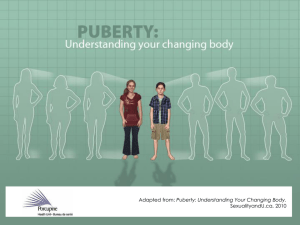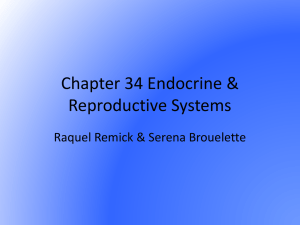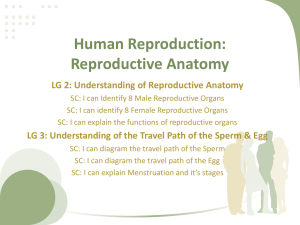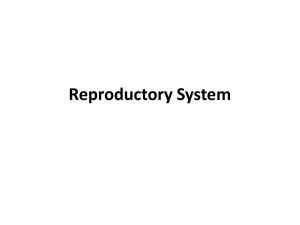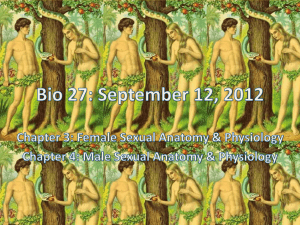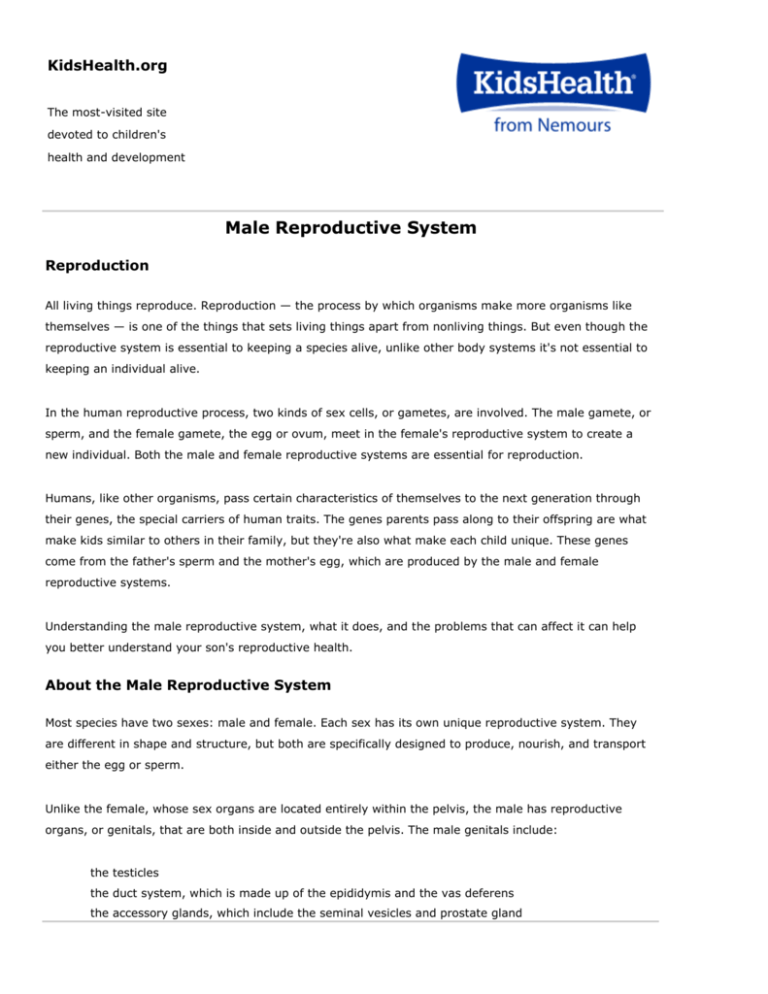
KidsHealth.org
The most-visited site
devoted to children's
health and development
Male Reproductive System
Reproduction
All living things reproduce. Reproduction — the process by which organisms make more organisms like
themselves — is one of the things that sets living things apart from nonliving things. But even though the
reproductive system is essential to keeping a species alive, unlike other body systems it's not essential to
keeping an individual alive.
In the human reproductive process, two kinds of sex cells, or gametes, are involved. The male gamete, or
sperm, and the female gamete, the egg or ovum, meet in the female's reproductive system to create a
new individual. Both the male and female reproductive systems are essential for reproduction.
Humans, like other organisms, pass certain characteristics of themselves to the next generation through
their genes, the special carriers of human traits. The genes parents pass along to their offspring are what
make kids similar to others in their family, but they're also what make each child unique. These genes
come from the father's sperm and the mother's egg, which are produced by the male and female
reproductive systems.
Understanding the male reproductive system, what it does, and the problems that can affect it can help
you better understand your son's reproductive health.
About the Male Reproductive System
Most species have two sexes: male and female. Each sex has its own unique reproductive system. They
are different in shape and structure, but both are specifically designed to produce, nourish, and transport
either the egg or sperm.
Unlike the female, whose sex organs are located entirely within the pelvis, the male has reproductive
organs, or genitals, that are both inside and outside the pelvis. The male genitals include:
the testicles
the duct system, which is made up of the epididymis and the vas deferens
the accessory glands, which include the seminal vesicles and prostate gland
the penis
In a guy who has reached sexual maturity, the two testicles, or testes, produce and store millions of tiny
sperm cells. The testicles are oval-shaped and grow to be about 2 inches (5 centimeters) in length and 1
inch (3 centimeters) in diameter. The testicles are also part of the endocrine system because they produce
hormones, including testosterone. Testosterone is a major part of puberty in boys, and as a guy makes his
way through puberty, his testicles produce more and more of it. Testosterone is the hormone that causes
boys to develop deeper voices, bigger muscles, and body and facial hair, and it also stimulates the
production of sperm.
Alongside the testicles are the epididymis and the vas deferens, which make up the duct system of the
male reproductive organs. The vas deferens is a muscular tube that passes upward alongside the testicles
and transports the sperm-containing fluid called semen. The epididymis is a set of coiled tubes (one for
each testicle) that connects to the vas deferens.
The epididymis and the testicles hang in a pouch-like structure outside the pelvis called the scrotum. This
bag of skin helps to regulate the temperature of testicles, which need to be kept cooler than body
temperature to produce sperm. The scrotum changes size to maintain the right temperature. When the
body is cold, the scrotum shrinks and becomes tighter to hold in body heat. When it's warm, the scrotum
becomes larger and more floppy to get rid of extra heat. This happens without a guy ever having to think
about it. The brain and the nervous system give the scrotum the cue to change size.
The accessory glands, including the seminal vesicles and the prostate gland, provide fluids that lubricate
the duct system and nourish the sperm. The seminal vesicles are sac-like structures attached to the vas
deferens to the side of the bladder. The prostate gland, which produces some of the parts of semen,
surrounds the ejaculatory ducts at the base of the urethra, just below the bladder. The urethra is the
channel that carries the semen to the outside of the body through the penis. The urethra is also part of the
urinary system because it is also the channel through which urine passes as it leaves the bladder and exits
the body.
The penis is actually made up of two parts: the shaft and the glans. The shaft is the main part of the penis
and the glans is the tip (sometimes called the head). At the end of the glans is a small slit or opening,
which is where semen and urine exit the body through the urethra. The inside of the penis is made of a
spongy tissue that can expand and contract.
All boys are born with a foreskin, a fold of skin at the end of the penis covering the glans. Some boys are
circumcised, which means that a doctor or clergy member cuts away the foreskin. Circumcision is usually
performed during a baby boy's first few days of life. Although circumcision is not medically necessary,
parents who choose to have their children circumcised often do so based on religious beliefs, concerns
about hygiene, or cultural or social reasons. Boys who have circumcised penises and those who don't are
no different: All penises work and feel the same, regardless of whether the foreskin has been removed.
What the Male Reproductive System Does
The male sex organs work together to produce and release semen into the reproductive system of the
female during sexual intercourse. The male reproductive system also produces sex hormones, which help a
boy develop into a sexually mature man during puberty.
When a baby boy is born, he has all the parts of his reproductive system in place, but it isn't until puberty
that he is able to reproduce. When puberty begins, usually between the ages of 9 and 15, the pituitary
gland — which is located near the brain — secretes hormones that stimulate the testicles to produce
testosterone. The production of testosterone brings about many physical changes. Although the timing of
these changes is different for every guy, the stages of puberty generally follow a set sequence.
During the first stage of male puberty, the scrotum and testes grow larger.
Next, the penis becomes longer, and the seminal vesicles and prostate gland grow.
Hair begins to appear in the pubic area and later it grows on the face and underarms. During this
time, a male's voice also deepens.
Boys also undergo a growth spurt during puberty as they reach their adult height and weight.
Sperm
A male who has reached puberty will produce millions of sperm cells every day. Each sperm is extremely
small: only 1/600 of an inch (0.05 millimeters long). Sperm develop in the testicles within a system of tiny
tubes called the seminiferous tubules. At birth, these tubules contain simple round cells, but during
puberty, testosterone and other hormones cause these cells to transform into sperm cells. The cells divide
and change until they have a head and short tail, like tadpoles. The head contains genetic material
(genes). The sperm use their tails to push themselves into the epididymis, where they complete their
development. It takes sperm about 4 to 6 weeks to travel through the epididymis.
The sperm then move to the vas deferens, or sperm duct. The seminal vesicles and prostate gland produce
a whitish fluid called seminal fluid, which mixes with sperm to form semen when a male is sexually
stimulated. The penis, which usually hangs limp, becomes hard when a male is sexually excited. Tissues in
the penis fill with blood and it becomes stiff and erect (an erection). The rigidity of the erect penis makes it
easier to insert into the female's vagina during sexual intercourse. When the erect penis is stimulated,
muscles around the reproductive organs contract and force the semen through the duct system and
urethra. Semen is pushed out of the male's body through his urethra — this process is called ejaculation.
Each time a guy ejaculates, it can contain up to 500 million sperm.
When the male ejaculates during intercourse, semen is deposited into the female's vagina. From the
vagina the sperm make their way up through the cervix and move through the uterus with help from
uterine contractions. If a mature egg is in one of the female's fallopian tubes, a single sperm may
penetrate it, and fertilization, or conception, occurs.
This fertilized egg is now called a zygote and contains 46 chromosomes — half from the egg and half from
the sperm. The genetic material from the male and female has combined so that a new individual can be
created. The zygote divides again and again as it grows in the female's uterus, maturing over the course
of the pregnancy into an embryo, a fetus, and finally a newborn baby.
Things That Can Go Wrong With the Male Reproductive System
Boys may sometimes experience reproductive system problems, including:
Disorders of the Scrotum, Testicles, or Epididymis
Conditions affecting the scrotal contents may involve the testicles, epididymis, or the scrotum itself.
Testicular trauma. Even a mild injury to the testicles can cause severe pain, bruising, or
swelling. Most testicular injuries occur when the testicles are struck, hit, kicked, or crushed,
usually during sports or due to other trauma. Testicular torsion, when one of the testicles twists
around, cutting off its blood supply, is also a problem that some teen males experience, although
it's not common. Surgery is needed to untwist the cord and save the testicle.
Varicocele. This is a varicose vein (an abnormally swollen vein) in the network of veins that run
from the testicles. Varicoceles commonly develop while a boy is going through puberty. A
varicocele is usually not harmful, although it can damage the testicle or decrease sperm
production. Take your son to see his doctor if he is concerned about changes in his testicles.
Testicular cancer. This is one of the most common cancers in men younger than 40. It occurs
when cells in the testicle divide abnormally and form a tumor. Testicular cancer can spread to
other parts of the body, but if it's detected early, the cure rate is excellent. Teen boys should be
encouraged to learn to perform testicular self-examinations.
Epididymitis is inflammation of the epididymis, the coiled tubes that connect the testes with the
vas deferens. It is usually caused by an infection, such as the sexually transmitted disease
chlamydia, and results in pain and swelling next to one of the testicles.
Hydrocele. A hydrocele occurs when fluid collects in the membranes surrounding the testes.
Hydroceles may cause swelling in the scrotum around the testicle but are generally painless. In
some cases, surgery may be needed to correct the condition.
Inguinal hernia. When a portion of the intestines pushes through an abnormal opening or
weakening of the abdominal wall and into the groin or scrotum, it is known as an inguinal hernia.
The hernia may look like a bulge or swelling in the groin area. It can be corrected with surgery.
Disorders of the Penis
Disorders affecting the penis include:
Inflammation of the penis. Symptoms of penile inflammation include redness, itching, swelling,
and pain. Balanitis occurs when the glans (the head of the penis) becomes inflamed. Posthitis is
foreskin inflammation, which is usually due to a yeast or bacterial infection.
Hypospadias. This is a disorder in which the urethra opens on the underside of the penis, not at
the tip.
Phimosis. This is a tightness of the foreskin of the penis and is common in newborns and young
children. It usually resolves itself without treatment. If it interferes with urination, circumcision
(removal of the foreskin) may be recommended.
Paraphimosis. This may develop when the foreskin of a boy's uncircumcised penis is retracted
(pulled down to expose the glans) and becomes trapped so it can't be returned to the unretracted
position. As a result, blood flow to the head of the penis may be impaired, and your son may
experience pain and swelling. A doctor may use lubricant to make a small incision so the foreskin
can be pulled forward. If that doesn't work, circumcision may be recommended.
Ambiguous genitalia. This occurs when a child is born with genitals that aren't clearly male or
female. In most boys born with this disorder, the penis may be very small or nonexistent, but
testicular tissue is present. In a small number of cases, the child may have both testicular and
ovarian tissue.
Micropenis. This is a disorder in which the penis, although normally formed, is well below the
average size, as determined by standard measurements.
If your son has symptoms of a problem with his reproductive system or he has questions about growth
and sexual development, talk with your doctor — many problems with the male reproductive system can
be treated.
Reviewed by: Steven Dowshen, MD
Date reviewed: October 2012
Note: All information on KidsHealth® is for educational purposes only. For specific medical advice,
diagnoses, and treatment, consult your doctor.
© 1995- 2014 The Nemours Foundation. All rights reserved.



